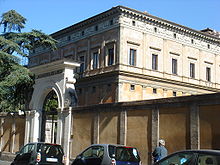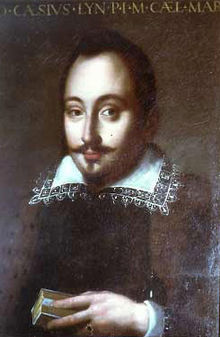- Accademia dei Lincei
-
The Accademia dei Lincei, (literally the "Academy of the Lynx-Eyed", but also known as the Lincean Academy), is an Italian science academy, located at the Palazzo Corsini on the Via della Lungara in Rome, Italy.
Founded in 1603 by Federico Cesi, it was the first academy of sciences to persist in Italy and a locus for the incipient scientific revolution. The academy was named after the lynx, an animal whose sharp vision symbolizes the observational prowess required by science. It was revived in the 1870s to become the national academy of Italy, encompassing both literature and science among its concerns.[1]
The Pontifical Academy of Science also claims a heritage descending from the first two incarnations of the Academy, by way of the Accademia Pontificia dei Nuovi Lincei ("Pontifical Academy of the New Lynxes"), founded in 1847.
Contents
The Accademia
The first Accademia dei Lincei was founded in 1603 by Federico Cesi, an aristocrat from Umbria (the son of Duke of Acquasparta and a member of an important family from Rome) who was passionately interested in natural history - particularly botany. The academy replaced the first scientific community ever, Giambattista della Porta's Academia Secretorum Naturae in Naples that had been closed by the Inquisition. Cesi founded the Accademia dei Lincei with three friends: the Dutch physician Johannes Van Heeck (italianized to Giovanni Ecchio) and two fellow Umbrians, mathematician Francesco Stelluti and polymath Anastasio de Filiis. Cesi and his friends aimed to understand all of the natural sciences. This emphasis that set the Lincei apart from the host of sixteenth- and seventeenth-century Italian Academies that were mostly literary and antiquarian. Cesi envisioned a program of free experiment that was respectful of tradition yet unfettered by blind obedience to any authority, even that of Aristotle and Ptolemy whose theories the new science was calling into question.
The four men chose the name "Lincei" (lynx) from Giambattista della Porta's book "Magia Naturalis", which had an illustration of the fabled cat on the cover and the words "...with lynx like eyes, examining those things which manifest themselves, so that having observed them, he may zealously use them".[2] Accademia dei Lincei's symbols were both a lynx and an eagle; animals with keen sight. The academy's motto, chosen by Cesi, was: "Take care of small things if you want to obtain the greatest results" (minima cura si maxima vis). When Cesi visited Naples, he met the polymath della Porta. Della Porta encouraged Cesi to continue with his endeavours.[2] Giambattista della Porta joined Cesi's academy in 1610.
Galileo was inducted to the exclusive academy on December 25, 1611, and became its intellectual center. Galileo clearly felt honoured by his association with the academy for he adopted Galileo Galilei Linceo as his signature. The academy published his works and supported him throughout his disputes with the Roman Catholic Church. Among the academy's early publications in the fields of astronomy, physics and botany were the study of sunspots and the famous Saggiatore of Galileo, and the Tesoro Messicano (Mexican Treasury) describing the flora, fauna and drugs of the New World, which took decades of labor, down to 1651. With this publication, the first, most famous phase of the Lincei was concluded. Cesi's own intense activity was cut short by his sudden death in 1630 at forty-five.
The Linceans produced an important collection of micrographs, or drawings made with the help of the newly invented microscope. After Cesi's death, the Accademia dei Lincei closed and the drawings were collected by Cassiano dal Pozzo, a Roman antiquarian, whose heirs sold them. The majority of the collection was procured by George III of the United Kingdom in 1763. The drawings were discovered in Windsor Castle in 1986 by art historian David Freedberg. They are being published as part of The Paper Museum of Cassiano dal Pozzo.[3]
Members
- Federico Cesi - founder
- Giovanni Demisiani - Greek theologian, chemist, mathematician, coined name "telescope"
- Anastasio de Filiis - polymath
- Johannes Van Heeck - Dutch physician
- Giambattista della Porta - Italian scholar, polymath and playwright
- Adam Elsheimer - German artist
- Giovanni Faber - Italian mathematician, coined name "microscope"
- Galileo Galilei - Italian physicist, mathematician, astronomer, and philosopher
- Johann Schreck - German Jesuit, Missionary to China and polymath
- Francesco Stelluti - mathematician
- Nicola Antonio Stigliola - Italian philosopher, printer, architect, and medical doctor
- Luca Valerio - Italian mathematician
- Carlo Sini - Italian philosopher
The Accademia is re-founded
In 1801, Abbot Feliciano Scarpellini with Gioacchino Pessuti founded the Accademia Caetani which took the name of Accademia dei Lincei,[4] but it underwent a true revival only in 1847, when Pope Pius IX re-founded it as the Pontificia accademia dei Nuovi Lincei, the Pontifical Academy of New Lincei.
The Reale Accademia dei Lincei
in 1874, Quintino Sella turned it into the Accademia Nazionale Reale dei Lincei, the Royal National Lincean Academy. This incarnation broadened its scope to include moral and humanistic sciences, and regained the high prestige associated with the original Lincean Academy. After the unification of Italy, the Piedmontese Quintino Sella infused new life into the Nuovo Lincei, reaffirming its ideals of secular science, but broadening its scope to include humanistic studies: history, philology, archeology, philosophy, economics and law, in two classes of Soci (Fellows).
Members
- Giusto Bellavitis
- Domenico Comparetti
- Benedetto Croce
- Albert Einstein
- Enrico Fermi
- Giovanni Gentile
- Theodor Mommsen
- Antonio Pacinotti
- Louis Pasteur
- Olinto De Pretto
- Augusto Righi
- Wilhelm Roentgen
- Ulrich von Wilamowitz-Moellendorff
The Accademia d'Italia
- see main article Royal Academy of Italy
During the fascist period the Lincean Academy was effectively replaced by the new Accademia d'Italia, the Italian Academy, but was not fully absorbed by that institution until 1939.[5] In 1949, after the fall of the fascist regime, at the suggestion of Benedetto Croce the Lincean Academy recovered its independence. A brief history of this period of the Accademia, as well as the complete inventory of publications and documents produced in the same period, can be found in the book by Cagiano De Azevedo & Gerardi (2005).
The Accademia Nazionale dei Lincei
In 1986, the Academy was placed under a statute that says it shall be composed of 540 members, of whom 180 are ordinary Italian members, 180 are foreigners, and 180 are Italian corresponding members. The members are divided into two classes: one for mathematical, physical, and natural sciences; the other for moral, historical, and philological sciences.
In 2001, the natural sciences were re-divided into five categories: mathematics, mechanics and applications; astronomy, geodesy, geophysics and applications; physics, chemistry and applications; geology, paleontology, mineralogy and applications; and biological sciences and applications. At the same time, the moral sciences were divided into seven categories: philology and linguistics; archeology; criticism of art and of poetry; history, historical geography, and anthropology; philosophical science; juridical science; social and political science.
Notes
- ^ Thomas G. Bergin (ed.), Encyclopedia of Renaissance Italy (Oxford and New York: New Market Books, 1987).
- ^ a b Della Porta's Life - From Giambattista Della Porta Dramatist by Louise George Clubb - Princeton University Press Princeton, New Jersey, 1965
- ^ Paper Museum, Warburg Institute
- ^ Accademia dei Lincei: Protagonisti: Feliciano Scarpellini
- ^ Fascist Italy, John Whittam, page 84
References
- This article draws material from the corresponding article in the Italian Wikipedia, retrieved 09:12, Feb 2, 2005 (UTC)
- Cagiano De Azevedo, Paola; Gerardi, Elvira, eds. (2005), Reale Accademia d'Italia. Inventario dell'archivio (Inventory of the Archive), Pubblicazioni degli Archivi di Stato - Strumenti, CLXVII, Roma: Ministero per i Beni Culturali e Ambientali - Dipartimento per i Beni Archivistici e Librari - Direzione Generale per gli Archivi, pp. lxxxiv+492, ISBN 88-7125-264-0, http://www.archivi.beniculturali.it/DGA-free/Strumenti/Strumenti_CLXVII.pdf (in Italian), freely available from the Ministero per i Beni Culturali e Ambientali - Dipartimento per i Beni Archivistici e Librari - Direzione Generale per gli Archivi (a branch of the Italian Ministero per i Beni e le Attività Culturali). The complete inventory of the Reale Accademia d'Italia, which incorporated the Accademia Nazionale dei Lincei between 1939 and 1944.
- O'Connor, John J.; Robertson, Edmund F. (August 2004), "The Accademia dei Lincei", MacTutor History of Mathematics archive, University of St Andrews, http://www-history.mcs.st-andrews.ac.uk/Societies/Lincei.html.
- Van Helden, Albert (May 24, 2004), Accademia dei Lincei, http://cnx.rice.edu/content/m11955/latest/, retrieved January 14, 2010, available at Connexions.
External links
- Official website, with brief history (in Italian).
- Official website in English
- Notes on the Accademia dei Lincei from the Scholarly Societies Project
- "
 The Scientific Societies of Italy" Popular Science Monthly 42 D. Appleton & Company. Wikisource November 1892 ISSN 0161-7370
The Scientific Societies of Italy" Popular Science Monthly 42 D. Appleton & Company. Wikisource November 1892 ISSN 0161-7370
Coordinates: 41°53′36″N 12°28′00″E / 41.89333°N 12.4666667°ECategories:- Science and technology in Italy
- Scientific societies
- 1603 establishments
- History of Rome
- National academies of sciences
Wikimedia Foundation. 2010.


